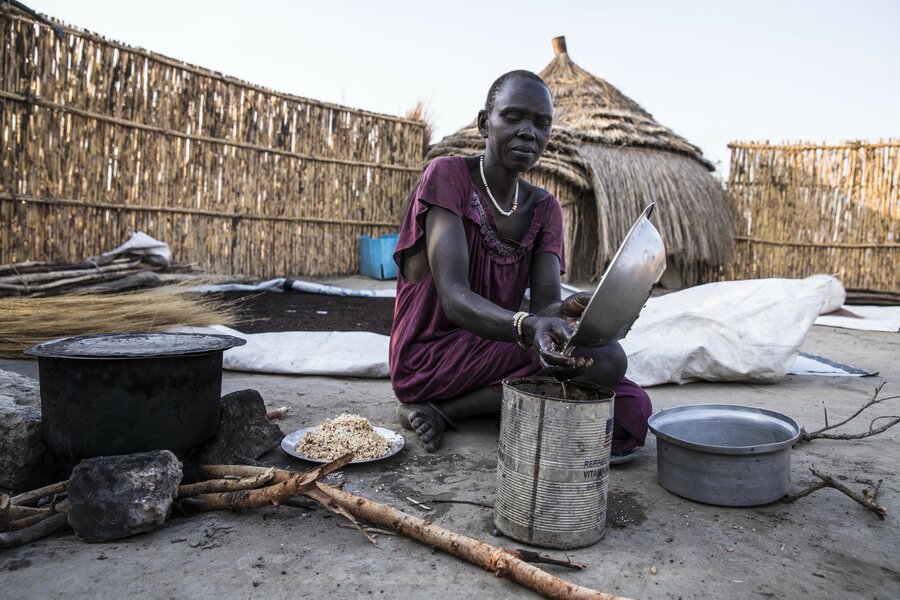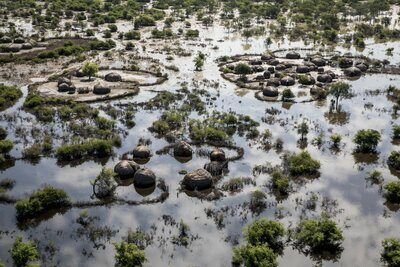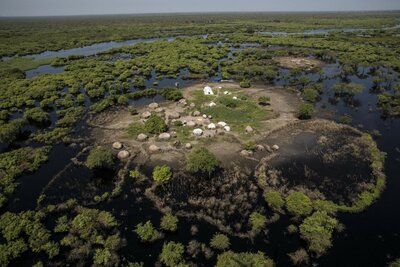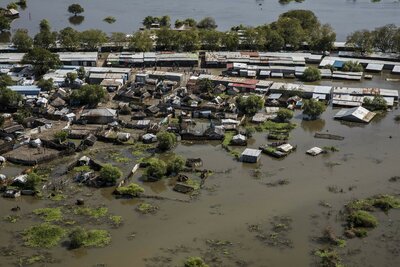Hunger deepening in South Sudan as floods follow drought and unresolved conflict

"We lost what we planted to the drought," says Nyabany Mun Roah, as she prepares a meal outside the simple thatched hut that doubles as a living room and bedroom in Karam, Uror County.
"Without assistance, we would have starved," added Nyabany, referring to food provided by the World Food Programme (WFP) and its partners as part of an emergency package to tide the most vulnerable through the toughest of times.
"Sometimes you end up asking, have the Gods forsaken us?"
Some 5.5 million South Sudanese, like Nyabany, are projected to be going hungry in early 2020 — according to forecasts from the last food security data prepared by Government and partners.
But experts warn that flooding in parts of the country since July means that the number of people in need is likely to increase in the coming months.
A deepening crisis

South Sudan is in trouble. But its problems go way beyond just a lack of food.
The country is still embroiled in a low-key conflict after being torn by years of bloodletting. Several peace deals were brokered, and broken. A fragile peace deal signed in September 2018 is largely holding and a delayed Transitional Government of National Unity is now expected to be formed in early 2020.
"South Sudan's leaders will understand that donor fatigue is real," said WFP Executive Director David Beasley on a recent visit to the country. "If we don't get the money we need, they are going to have greater problems than they would have ever imagined. So, they need to bring peace."
For many years, donors have been extremely supportive of South Sudan but like the suffering South Sudanese people, they are now growing tired of continually growing needs with no real solution to the country's woes in sight.
Parts of the country were hit by severe drought in early 2019. This was followed by widespread flooding since July that has affected close to 1 million people and destroyed over 73,000 metric tons of cereals, which were ready for harvest.
Some farmers, who somehow managed to survive the conflict since 2013, were this year hammered by the drought followed later by the heavy rains.
"Sometimes you end up asking, have the Gods forsaken us?" asks Nyabany.
The country requires 1.3 metric tons of cereals annually, but produced just over half that — leaving a shortfall of over 525,000 metric tons, which is mostly covered by imports from neighbouring countries and overseas.
The combined impacts of drought, catastrophic flooding, rising poverty and a chronic economic downturn — along with prolonged political challenges — are pushing people over the brink unless food assistance is scaled up. This time, however, bringing in more food and nutrition support has its own challenges.
A crippling funding shortage
WFP, which this year ramped up its assistance to reach 4.6 million people with life-saving support, now faces a crippling shortage of funding from donors that threatens to jeopardize humanitarian work in the new year.
"If we don't get funding in the next few weeks and months, millions of people will face hunger," says Beasley. "We need support, we need help and we need it now." WFP's and its partners' task in the coming months is to stop this from happening.
Humanitarian assistance has become a fragile lifeline in most areas of the country since famine was pushed back in 2017. WFP now needs US$270 million to avert a possible famine in 2020. Of this, US$100 million is required by the end of the year to buy and pre-position food ahead of the rainy season which will start in May, cutting road access to about 60 percent of the country.
If WFP doesn't get the extra funding, it will be forced to take harsh decisions — including cutting planned assistance to 1 million vulnerable people.
People pushed over the edge



In Pibor town, where the airstrip, schools, markets and whole communities were submerged by flood waters, food prices have doubled, and in some cases trebled.
Livestock such as cattle, goats and sheep perished and grazing pasture was wiped out. There is an increasing risk of disease among people and the cattle their survival depends upon.

Maban County in Greater Upper Nile, which is not usually affected by floods, was also hit hard while in Jonglei, the rains were the heaviest in four decades.
In late October, the government declared a state of emergency in Bahr el Ghazal, Greater Upper Nile and Greater Equatoria. Heavy rains worsened the already critical humanitarian situation, because they hit areas that already had high humanitarian needs. More than half of the flood-affected counties are currently classified as facing extreme levels of acute malnutrition.
Even with more support, the effects of drought, years of conflict and floods will be felt for long — even if the flood waters recede and guns finally fall silent.
But surprisingly, the South Sudanese people have not lost all hope, perhaps because that is all they have left.
Dreams of a better future

Nyabany embodies the resilient South Sudanese spirit. Cut and sealed off, her village in Karam, like many others, is remote. Villagers walk for days to reach nearby towns. Notwithstanding the challenges, Nyabany fights daily to earn a living, care for her family successfully and build a better future for them all.
Forced to drop out of school and married off early, she vowed that she would change what seemed to be the destiny of suffering her five children faced.
"The idea came from my parents. We had nothing to survive on," she says. "After I got married, my parents were able to survive with the cattle they received as bride price."
Listening to Nyabany, one gets the impression that her own personal dreams were deferred but may soon live on through one, if not all, of her children. "If I had the opportunity to attend school, I could have become a doctor or a teacher," she adds
With the little she earns, she can put her children through school. Thanks in part to WFP support, she is able to make it and to survive, one day at a time.
Little gains

While providing life-saving food distributions to the most vulnerable in areas of the country indirectly affected by conflict, WFP also assists communities to build and rehabilitate assets such as wells, flood control dykes and small irrigation schemes that should help them to survive future shocks.
WFP also provides food for school meals to encourage parents to not only send children to school but to keep them in school and give them a future.
In some areas with agricultural potential, WFP enables farm-to-market access by rehabilitating rural roads. Where there is a surplus, WFP buys cereals locally for assistance schemes while scaling up cash transfers in places with functioning markets.
So far in 2019, WFP has paid out US$32 million in cash transfers across the country, increasing cash flows into local economies and strengthening them. However, for all this to succeed, more sustained funding and peace are both key.


